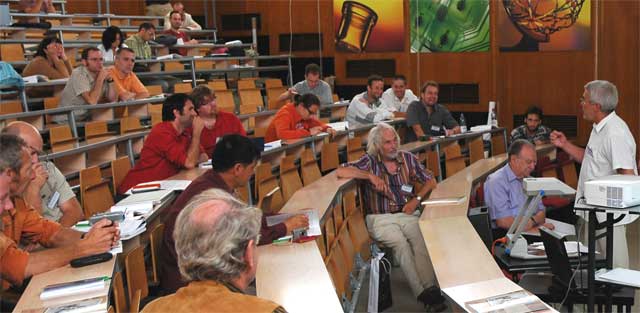LOESSFEST'09 | Aug. 31st – Sept. 3rd, 2009 |Novi Sad-Serbia
Depositional Cycles Within Late Pleniweichselian Loess in Poland and Western Part of Ukraine
Zdzisław Jary1, Ciszek, D.2
1Institute of Geography and Regional Development, University of Wroclaw, 50-137 Wroclaw, Poland
2Polish Geological Institute, Lower Silesian Branch, 53-122 Wroclaw, Poland
Fifteen of the most complete Late Pleistocene sequences were chosen for advanced studies from the northern margin of the European loess belt extending from SW Poland to NW part of Ukraine. Within each studied outcrop several sections have been selected for careful cleaning and sampling. All these profiles were sampled in vertical continuous sections at close intervals (5–10 cm) and documented in respect of their sedimentology, palaeopedology and stratigraphy. The following analyses were conducted: grain-size distribution (laser diffraction method), magnetic susceptibility, contents of CaCO3 and organic carbon. Also analyses of geochemical composition and mineralogy of clay fraction were carried out for the selected profiles. TL (71 samples), OSL (23 samples) as well as three AMS 14C dating were performed. 14C dating was carried out on organic macroremnants and humin fractions extracted from the sediments.

Detail analysis of grain-size indices performed for Upper Pleniweichselian loess (above Gi/LMd=komorniki=Dubno=Bryansk soil complex) revealed the presence of several short depositional cycles within the thick loess sequences, which may indicate short climate variations during the time of loess deposition. Relatively coarse-grained loess is alternated with fine-grained loess. Time of high dust influx coincided with severe climate conditions inferred from grain-size variations. Coarse silt was mainly deposited and transported for short distance from close-situated source areas. Periods of fine-grained loess accumulation and development of weak pedogenic gley horizons, marked by relatively low values of magnetic susceptibility, represent warmer episodes. Aeolian dust was transported from distant source areas. Depositional cycles in Upper Pleniweichselian loess are also marked both on MS value and CaCO3 content curves.
The number of depositional cycles, which can be distinguished in Upper Pleniweichselian loess (LMs+LMg), is not the same in each investigated section. There are usually 1-2 weak tundra-gley horizons within middle younger loess (LMs) and 2-4 depositional cycles within upper younger loess (LMg). At Novyj Mylatyn section (Lviv surrounding) eight initial tundra-gley horizons were noted within middle and upper younger loess. Current state of investigation brings many uncertainties concerning the origin and palaeoenvironmental interpretation of these features. Depositional cycles recorded in loess successions might be linked with local or regional oscillations of dust storms frequencies. It is possible, that they were triggered by short-duration (millennial) climatic oscillations. Short-term climatic cycles, recorded in Upper Pleniweichselian loess sequences from Poland and West Ukraine, can be correlated with the Dansgaard-Oeschger and Heinrich events noted in the ice-cores from Greenland and North-Atlantic marine profiles, respectively. This implies that millennial-scale climatic variations were similar in a large part of the northern hemisphere. The attempt to establish a reliable and fine chronological framework for Upper Pleniweichselian loess by means of TL, OSL and AMS 14C dating techniques was not completed successfully. One of the main reasons is a standard error of these techniques, comparable with dated periods. Reliable reconstruction of these oscillations is possible only in thick subaerial loess sequences. Polish and Ukrainian overall profiles are distinctively different. Nevertheless, they show several correlation points, which can be considered as potential new stratigraphic markers.
Further investigations of depositional cycles, which are recorded in Last Glacial loess sequences in Poland and NW Ukraine will be of crucial importance for palaeogeographical reconstructions of loess areas. It can be an important step to evaluate precise correlation between continental, marine and ice-core events.



